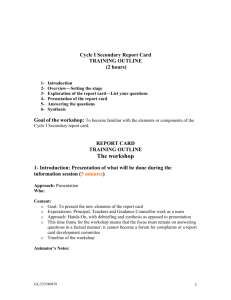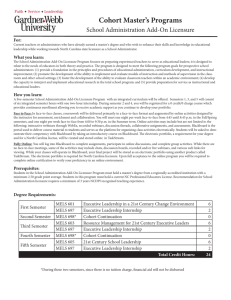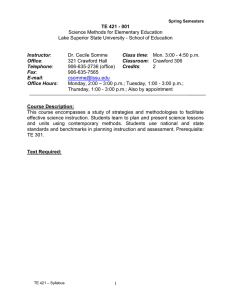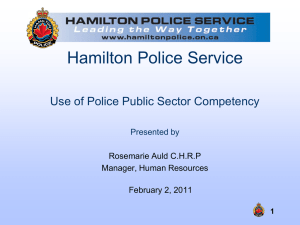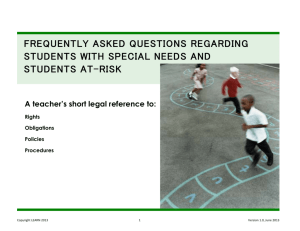New Orientations in Evaluation and Reporting
advertisement
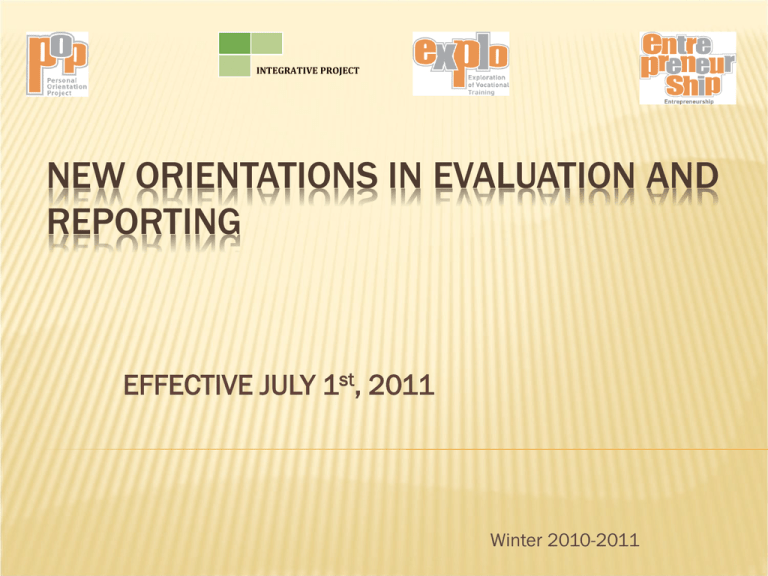
INTEGRATIVE PROJECT NEW ORIENTATIONS IN EVALUATION AND REPORTING EFFECTIVE JULY 1st, 2011 Winter 2010-2011 WHAT ARE THE MAJOR CHANGES? Uniform provincial report card 3 formal reporting periods with weightings for each term Evaluation of knowledge and competencies Reduction in number of evaluation criteria (based on the Framework for the Evaluation of Learning) PROVINCIAL REPORT CARD FOR ELEMENTARY AND SECONDARY SCHOOL 1st report card Results for Term 1 (count for 20% of the student’s final mark) 2nd report card Results for Term 2 (count for 20% of the final mark) Includes: •for Term 3, a competency report covering learning as a whole for the year (results count for 60% of the final mark) AND • a final mark Last report card of the year 3 WHEN TO REPORT Written communication No later than October 15th Term 1 report card No later than November 20th Term 2 report card No later than March 15th Last report card of the year (Term 3 report card + Final result) •No later than July 10th WEIGHTING AND WORDING ON REPORT CARD Integrative Project Secondary V Weighting Wording in report card Carries out an integrative project Makes connections between elements of his/her learning 100% Integrative Project 5 RESULTS FOR TERMS 1 AND 2 Entrepreneurship (100%) Term 1 (20%) Term 2 (20%) Term 3 (60%) Final Mark Integrative Project (100%) Personal Orientation Project (100%) Exploration of Vocational Training (100%) Subject mark Group average For Terms 1 and 2, the teacher communicates a mark expressed as a percentage that reflects the knowledge and subject-specific competencies a student has acquired, based on the evaluations carried out during the term (tests, assignments, etc.). 6 RESULTS FOR TERM 3 (COMPETENCY REPORT) Entrepreneurship (100%) Term 1 (20%) Term 2 (20%) Term 3 (60%) Final Mark Integrative Project (100%) Personal Orientation Project (100%) Exploration of Vocational Training (100%) Subject mark Group average For the last term, the teacher prepares a competency report that covers the student’s learning as a whole for the year (knowledge and subject-specific competencies) and communicates a mark expressed as a percentage. 7 FINAL MARK Entrepreneurship (100%) Term 1 (20%) Term 2 (20%) Term 3 (60%) Final Mark Integrative Project (100%) Personal Orientation Project (100%) Exploration of Vocational Training (100%) Subject mark Group average The report card for the last term also includes a final mark, which is calculated automatically using the results of all three terms, in accordance with the respective weighting of each term (20%– 20%–60%), as well as the results on the compulsory examinations set by the Minister for elementary school and for Secondary Cycle One. 8 RESULTS SHOWN ON THE REPORT CARD A detailed result for each competency (or component) in: language of instruction second language mathematics science Only a subject mark for all other subjects 9 THE UNIFORM REPORT CARD WILL ALSO INCLUDE….. • •Comments on subject learning •Comments on at least 2 of the 4 following competencies (in Terms 1 and 3): Exercises critical judgment Organizes his/her work Communicates effectively Works in a team MELS EXAMS MELS Compulsory Exams MELS Uniform Exams (Secondary ) 20% of Final Mark (calculated on final report card of the year) 50% of Final Mark - Sanction rules still apply (calculated on final report card of the year) COMPULSORY USE OF FRAMEWORKS FOR THE EVALUATION OF LEARNING MELS has developed new frameworks for each subject area, effective July 1st, 2011. Frameworks include: - Weighting of competencies, where applicable - Evaluation criteria, with explanations - Verification of acquired knowledge, and evaluation of applied knowledge EVALUATION CRITERIA Revised and simplified Accompanied by an explanation Sometimes followed by an asterisk (*), indicating: that the student must be provided with feedback on this criterion but that the criterion is not considered when determining the student’s mark 13 STANDARDS & PROCEDURES At the start of the school year, the school provides parents with a summary of the Standards and Procedures for the evaluation of student learning, specifying: • the main types of evaluation to be carried out and • when they will take place SUMMARY OF COMPULSORY ELEMENTS Uniform provincial report card Number of report cards, deadlines, and weightings of each term (20%, 20%, 60%) Summary of Standards and Procedures for the evaluation of student learning provided to parents at the beginning of school year Student knowledge officially taken into account Use of new Frameworks for the Evaluation of Learning REDUCTION IN NUMBER OF MARKS ENTERED MELS RESOURCES Progression of Learning: http://www.mels.gouv.qc.ca/progression/secondaire/index_en.asp Secondary Evaluation Frameworks for each subject (2011-2012): http://www.mels.gouv.qc.ca/sections/publications/index.asp?page=fiche&id=16 16 QEP: Cycle 1 http://www.mels.gouv.qc.ca./sections/programmeFormation/secondaire1/in dex_en.asp Cycle 2 http://www.mels.gouv.qc.ca./sections/programmeFormation/secondaire2/in dex_en.asp
